Seborrheic Dermatitis Information
Page Contents
Seborrheic Dermatitis is a kind of skin disease characterized by the inflammation of the scalp or the face along with the appearance of scaly and flaky substance over the surface of the skin. It generally affects the areas of the skin which are in contact with the various glands present in our body. It is actually a more severe case of Sebborhea or skin eczema. One usually experiences a great deal of itching at the affected area and this causes further inflammation thereby making the affected area turn red in color.
Although the term ‘Seborrheic Dermatitis’ is also used in place of dandruff in many cases owing to the similarity of the nature of the skin disorders, yet they can be distinguished on medical terms. A person suffering from Sebborheic Dermatitis has an excessive oily skin with the growth of flaky scales and redness of the affected area. Whereas a person with dandruff only has scales over the scalp without the reddening of the area. Moreover as mentioned earlier, dandruff problem persists only on the scalp but Seborrheic Dermatitis may be caused at any place affecting the skin. So it can be of various types based on the location of occurrence such as Seborrheic Dermatitis of the scalp, face, chest, nose, ears, eyelids, or the chest.
Seborrheic Dermatitis Causes
The exact cause of Seborrheic Dermatitis is still unknown to the doctors yet the prevalent causes are ascribed to a number of factors such as the following:-
- A yeast known as Malssezia globosa is considered to be the pathogen for Seborrheic dermatitis on scalp. Its presence is believed to cause inflammation of the scalp that toxifies the skin and causes further irritation. Its growth is supported by saturated fatty acids and triglycerides.
- Seborrheic Dermatitis is a condition that is quite often born out of stress related factors as well as poor health conditions caused by illness and fatigue. Men and women suffer from dandruff and erythemal problems especially due to psychological stress and sleep deprivation which in the later stage causes Seborrheic Dermatitis.
- The presence of Vitamin A in an excessive quantity causes hypo alimentation in both children and adults, thereby leading to Seborrheic Dermatitis. In the other way the deficiency of Vitamin B6 (also known as Biotin) as well as Vitamin B2 (also called Riboflavin) causes the appearance of scaly flakes over the skin and the reddening of the area.
- Those suffering from nervous disorders such as Parkinson’s disease and immunodeficiency problems are prone to this skin disorder. Moreover, a heart patient or a person tested positive for HIV may also suffer from Seborrheic Dermatitis.
- The drying up of the skin during winters may aggravate the occurrence of this disease. This is the reason why the people living in the cold climatic regions suffer from greater number of dandruff and seborrhea related problems.
Seborrheic Dermatitis Symptoms
Seborrheic Dermatitis on Scalp
The most common symptom of Seborrheic Dermatitis is the occurrence of dandruff over the scalp as a flaky and scaly substance. The flakes are usually grey, white or yellow in color depending on the type of skin of the affected person as well as the stage of the development of the disease. The flakes are mostly to be seen in those parts of the body having hair follicles which usually gets inflamed. Infants who are below 3 months old may also suffer from Infantile Seborrheic Dermatitis which is characterized by the occurrence of yellow crusty flakes around the hairline or on the scalp also known as Cradle Cap. It naturally withers away within 8 to 12 months of age. However it takes place along with diaper rashes and may be confused to be the same.
Seborrheic Dermatitis on Face and Body
In case of severe Serborrheic Dermatitis, yellowish oily and thick flakes appear on the eyebrows or near the eyelashes, in the ear canal, on the forehead, on the middle chest, and on the upper back. The flakes may also appear anywhere over the skin surface including the face, behind the ears and other skin folds. These may be accompanied by mild redness, hair loss, the formation of skin lesions, itching, soreness and pain which may cause a total discomfort to the individual affected. The condition may worsen and cause permanent harm to the hair follicles if not treated well under the guidance of a doctor.
Seborrheic dermatitis can also take place in the form of Psoriasis Seborrheic Dermatitis and Seborrheic Dermatitis acne. All these may lead to permanent loss of hair if kept untreated for long.
Seborrheic Dermatitis Pictures
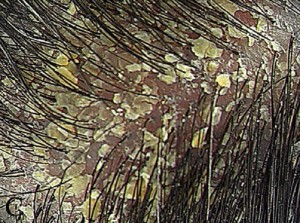
Picture 1 : Seborrheic Dermatitis on Scalp
Source : Nationalnursingreview
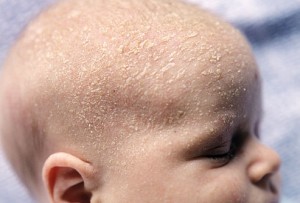
Picture 2 : Cradlle Cap in Infants
Source : Webmd
Picture 3 : Seborrheic Dermatitis behind the ears
Source : skinsight
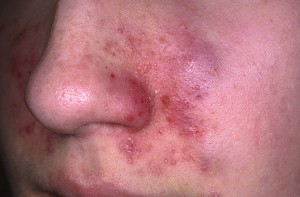
Picture 4 : Seborrheic Dermatitis Face
Source : lin.uiowa
Seborrheic Dermatitis Treatments
Seborrheic Dermatitis can be treated in a number of ways. But the primary way to prevent it is to maintain ones health and hygiene. For an effective treatment of the disease one needs to either consult a dermatologist or undertake home therapy measures.
The shampoos suggested for the treatment of this disease are basically anti-dandruff in nature containing anti-fungal ingredients. For Seborrheic Dermatitis Scalp treatment, the first measure shall be to clean the affected scalp properly so as to ensure no vulnerability to bacterial or fungal infections which are the main causes behind the inflammation of the hair follicles. Medicated shampoos which contain salicylic acid, climbazole, piroctione olamine, isotretinoin, zinc pyrithione, ketoconazole, tar, selenium sulfide are recommended for treating Seborrheic Dermatitis. Creams or lotions which contain corticosteroid, and anti-fungal topical such as ketoconazole and ciclopirox are prescribed for treating both Cradle Cap in infants and Seborrheic Dermatitis. Creams and gels containing topical cortisone help in reducing the inflammation of the affected area which causes it to itch. Besides these, medications other than the above anti-fungals which may be useful in the treatment of seborrheic dermatitis but are not encouraged by medical practitioners because of their harmful side-effects are lithium gluconate and succinate, coal tar, topical steroids and Isotretinoin. However, vitamin ointments and tablets are allowed to be taken in case of such a skin disorder.
Seborrheic Dermatitis Natural Treatment
The natural treatments for seborrheic dermatitis are usually herbal extracts of plants, fruits and other naturally available substances. Those which are recommended by medical experts are the topical application of aloe vera, honey mixed with warm water, a plant extract known as Monarda fistulosa, tea tree oil, avocado and viola tricolor. Fruits and vegetables rich in Vitamin B2, 3, 6, and 7 are recommended by doctors as fruits are great antioxidants and are also beta-carotine in nature. The natural remedies are usually home made in nature with the help of real vegetable and fruit extracts. Among the spices, garlic is said to have the ability to reduce scalp infection. And so a paste of garlic and tomato are considered to heal the infection in an effective manner. Besides this, the application of milk of magnesia on the face is said to heal seborrheic dermatitis. The application of these can ensure natural cures for seborrheic dermatitis.
Seborrheic Dermatitis Clinical Treatment
Seborrheic Dermatitis is a skin disorder which if not treated at the initial stage may lead to permanent atrophy. So it is best to get treated under the guidance of a skin expert or a Dermatologist so as to avoid any risks that may be involved in case of following an improper home therapy for treating seborrheic dermatitis. In case of severe Seborrheic Dermatitis, phototherapy is conducted so as to inhibit the growth of the pathogens of the disease by laser therapy.
References
http://en.wikipedia.org/wiki/Seborrhoeic_dermatitis
http://www.mayoclinic.com/health/seborrheic-dermatitis/DS00984
http://www.skinsight.com/adult/seborrheicDermatitis.htm
http://www.nlm.nih.gov/medlineplus/ency/article/000963.htm

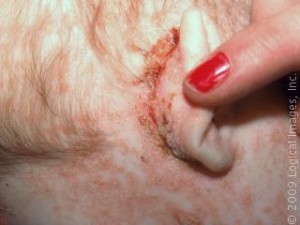
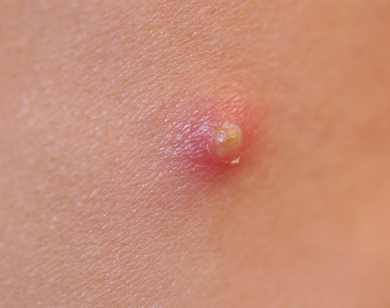
No Responses